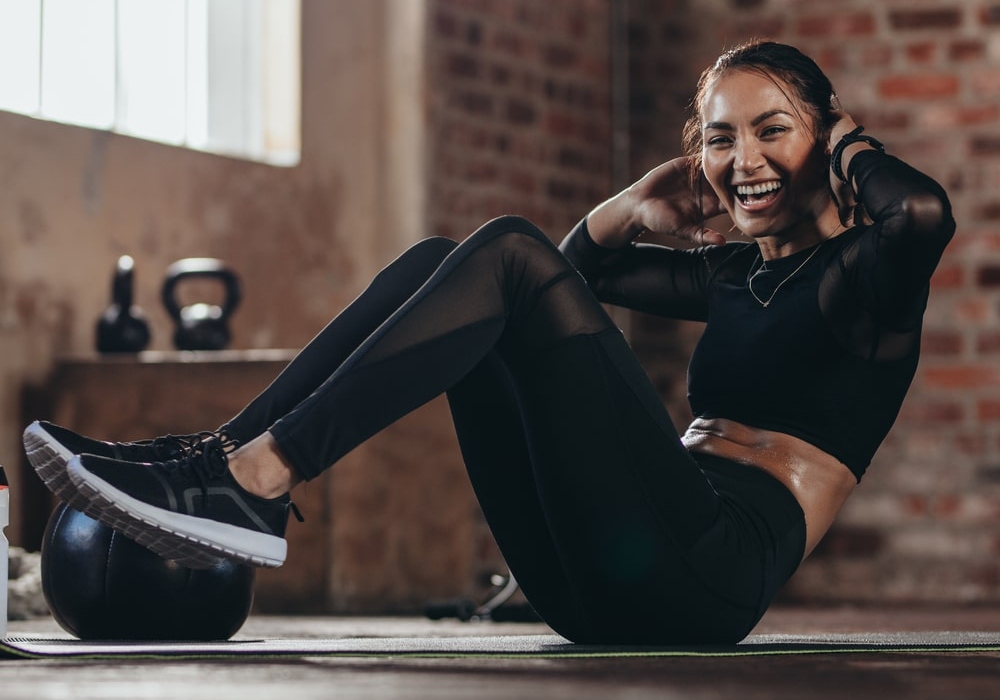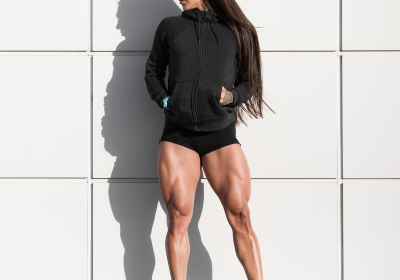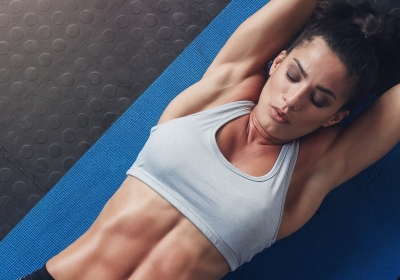VIDEO
Barbell Front Lunge
- Core
- Gluteus
- Quads
- Hamstrings
- Calves
Level:Intermediate
Trainer:Nick Taylor
Equipment:Barbell
Barbell Front Lunge
- Core
- Gluteus
- Quads
- Hamstrings
- Calves
Level:Intermediate
Trainer:Nick Taylor
Equipment:Barbell
Start standing, feet shoulder-width apart with a barbell on your trapezius in front grip. Step forward lowering until the knee is hovering just above the floor. Drive through the front leg and return to the standing position and repeat the step process with the opposing leg.
save to ...
RECOMMENDED FOR YOU
ARTICLES
The oblique abdominal muscles are several groups of abdominal muscles on the sides of the core. The external oblique muscle lies on top and the internal oblique muscle - below it. Functional exercises for training them are bending, turning to the sides, and other rotating movements.
However, in order to work your obliques properly, you must remember that most exercises for the oblique muscles involve the other abdominal muscles, the inner transverse muscles, in particular. That's why you need to be able to consciously engage certain areas of the abs during the workout.
The oblique muscles represent the lateral part of the abdominal area. They act as the main rotators of the body. They are represented by two separate muscles, depending on depth and layer:
The outer oblique abdominal muscle forms the superficial layer. It is usually the target of training. It anatomically begins from ribs 5-12.
The internal muscle originates from the lumbosacral fascia, iliac crest, and inguinal ligament. It is attached to the area of the white line, cartilages of ribs 9-12, and pubic crest.
The main task of the oblique abs is to rotate the torso. Although, in addition to the main one, the muscle performs a number of functions:
Tilting of the torso.
Flexion.
Lowering the ribs.
The tension of the anterior abdominal chest wall.
Bilateral contraction.
In general, in order to work your abs properly, it is necessary to follow simple recommendations:
Eat lightly 2-2.5 hours before the exercise. If you train with an empty stomach, you will not work out to your full potential, which means that the workout will be ineffective. An overfilled stomach can also leave negative consequences, such as nausea and severe dizziness.
Warm up your muscles by doing light exercises. Jump, run on the spot or on a machine, do simple tricks like turns, twists, and turns.
Do not overdo it! You don't need to exhaust yourself every day. Try 2-4 times a week - that will be enough for a nice and shapely belly.
Each exercise should stretch your muscles. You should feel how they are tensed. If this is not there, then you are doing something wrong.
Do not eat immediately after the workout. If you feel very hungry, snack on an apple or drink a glass of water. Do not eat after one hour at the earliest.
Read more
One of the most important running muscles is the quadriceps - the large muscle at the front of the thigh. It has been scientifically proven that regular strength training improves workout performance and reduces the risk of injury, as well as strengthens your back, and leg muscles, making your running more productive.
The quads, also known as the quadriceps muscle, is a group of muscles located at the front of the leg above the knee. It is one of the largest and strongest muscles in your body that consists of four heads: fastus medialis (medial wide), vastus intermedius (intermediate wide), vastus lateralis (lateral), and rectus femoris (straight thigh muscle). Almost every action performed by the legs involves two or more heads of the quadriceps. The quadriceps muscle plays an important role at the beginning of the movement (quick start) and during ascent and descent in elevated positions - which is why you may experience painful sensations in this area of the leg after an intense uphill workout.
According to researchers at the University of Delaware, strong quadriceps act as cushioning and can protect the knees and the entire musculature of the hip from common running injuries. Often many runners are injured because they have weak and underdeveloped quadriceps, so it is especially important to strengthen them.
By training and strengthening the quads, you can get the following benefits when running:
Increased speed. Strong quadriceps help you tackle steep hills and climbs more easily and make pushing off the ground more powerful, resulting in increased speed.
Reduced injuries. According to research, poorly developed quadriceps are often associated with many running injuries. For example, a common injury such as the 'runner`s knee' results from weakness in these muscles, which are unable to stabilize the knee joint during the movement.
Increased endurance. Strengthening the quadriceps muscle will make your running more effortless and efficient, which contributes to increased running volume and endurance.
Training
The quadriceps occupy 70% of the muscle mass of the leg, so it is their development that is fundamental in leg training. The main exercise for developing the quadriceps is the squat. But, for beginners, at the first stages of training, it is better to start with leg curls sitting in an exercise machine, leg press, and hyperextensions to strengthen the lower back, to avoid injuries, in order to prepare the base for the heavy squats. It is a good idea to include squats in your training plan after about six months of training.
Read more
To work out the perfect buttocks, you need to know what functions they have. In this article, you may read everything about the structure and functions of the gluteus muscles. So, let’s start examining the glutes right now!
First things first, you need to know that glutes consist of three separate parts: large, medium, and small. Accordingly, the functions of the glutes reflect a combination of the functions of these three muscles, and if any of the muscles are not used, then we lack some of them, and, as a result, we do not get the desired look of the buttocks. Probably, it is time to have a closer look at every glute muscle.
The gluteus maximus is the largest of this group of muscles and can reach the thickness of 2-3 cm. It has a rhomboidal shape and almost completely o covers the middle and small gluteus maximus, being on top. In fact, it is this muscle that we usually associate with the considered area of the body that creates the main visible volume.
Here are the main functions of the gluteus maximus:
maintains the position of the torso when the person is standing
assists in extension of the torso after bending over
rotates the hip outward
acts in hip extension.
This muscle is very active during stair climbing and different types of stepping on an elevated surface. It is involved as soon as you change from stepping to running. It is active during upward jumps and various pushing movements of the legs. Besides, the gluteus maximus works together with other muscles in squats and all exercises involving the extension of the thigh and torso.
The middle gluteal muscle (lat. musculus gluteus medius) has a triangle-like shape. It is located under the gluteus maximus but is visible from behind and the side.
The main functions of the middle gluteus muscle are:
extends the hip to the side
participates in the inward and outward rotation of the hip
participates in the torso straightening
And the last, but no less important is the gluteus minimus. This muscle is not visible from the outside because it is the deepest of all three muscles and is completely overlapped by the gluteus medius and gluteus maximus. The shape of the small gluteus maximus resembles the middle gluteus maximus, but it is thinner.
In fact, the functions of this muscle are almost similar to that of the gluteus medius, and they usually work in tandem to create a beautiful shape of your buttocks.
If you are working out your entire body in one workout, do it at least three times a week. Choose one exercise for your gluteus and incorporate it into your program. To avoid stagnation, change exercises after 1-2 workouts.
If you prefer splits, choose 1-2 movements and do it on your leg workout day. Keep in mind that most glute exercises also load the muscles of the posterior surface of the thigh. So if you want to do a heavy deadlift or leg press in a machine, it is better to start with them. Otherwise, the muscles will get tired and you will not be able to work out fully.
We hope that you know more about your glutes right now and your workout will be more effective! Have a nice shape, dear friend.
Read more
Hamstring muscle training is often neglected, but for most athletes, however, it is very important because strong hamstrings help avoid many injuries.
They are a group of powerful muscles that extend from the pelvis to the knee at the back of the upper leg. Their two main roles are to extend the leg (pull it back) and bend the knee, movements we use both in mountain walking or running and in everyday life. We engage and overuse them more than we realize, which creates tension and can lead to acute or chronic injuries due to overuse. For example, when you run or hike up a mountain, it may seem like you are primarily using your quadriceps, but you are also straining your hams, especially if you are overzealous or taking a big step to navigating over rocks or roots.
These muscles consist of three parts: the semi-tendon muscle, the biceps femoris muscle, and the semitendinosus muscle. Together they form a large group of muscles that work at the base of the thigh. Their main function is to bend the leg at the knee joint.
Before performing any strength exercises, it is important to warm up and stretch the hamstring muscles well, because the muscles are often in a contracted condition.
Training
It is better, to begin with, a 5-10 minutes light workout. This can be cycling, running, etc. Such workouts are good for warming up before stretching, after which you can proceed to the main workout. Training cool muscles is not a good idea.
Wise advice for beginner athletes who want to train with extra weight - use a lighter load and more reps at first to gradually develop muscle strength.
There are many exercises that do not directly target your hamstrings, but where they help your hamstrings, such as pull-ups, lunges, and squats. However, to develop them well, it is also important to do some isolation exercises where you focus directly on your hams. To help you on your way, we decided to list the most important exercises below.
Hamstrings Compression helps relieve pain and tightness.
Stretching relieves stress and helps strengthen the ligaments in the back of the knee as well as the hamstrings.
Quadriceps stretching with support. This exercise will strengthen your hams instead of your quadriceps. It also improves knee mobility.
Leg lift with resting on arms. Lifting one leg is aimed at pumping the glutes, as well as strengthening the hamstrings.
Wall Squats. Such squats will strengthen your knees and also reduce pain if any. The exercise works all the muscles that are connected to the knees.
Lunges also engage your hamstrings, glutes, inner thigh muscles, and calves. The strength of these muscles determines the strength of your knees. The stronger they are, the more tension they will absorb, thus preventing injury and pain.
Exercises with a roller are a perfect way to massage and relax your muscles.
Read more
The core is a series of muscles that start under the pectoral and extend to the pelvis. It also includes several groups in the back and other groups throughout the torso. A 'strong back' means a good physique and a healthy body. If you want to learn how to do this, learn to exercise at home or at the gym. Once you have achieved this strength, you can also learn to maintain it.
The midsection is the area of the body often referred to as the core and it involves everything in that area including the front, back and sides. It includes:
lower back.
the traverse abdominis (TVA);
erector spinae;
obliques;
If they are week it could cause lower back and waist pain. However, taking care of them can keep your posture healthy and make you stronger in other exercises like running and walking.
Training. One of the best core exercises is a plank. It provides minimal movement but maximal effort, demanding you to support your body on your hands and toes during holding your body in a straight line from your shoulders to your ankles. Also, you can rest on your knees If you need it or make it more difficult by extending your arms so you’re supported by your hands.
Bridge. Lie down on the floor. Put your arms straight down on the floor near your hips. Bend your knees. Lift your hips up and down.
Superman. Do a little push-up. Lie with your face down and stretch and arms forward and your legs backward.
V-Jumps. Sit on a bench or chair, lift your legs, tilt the core slightly forward so that your body forms a 45-degree angle. From this position jump up extending your hands above your head.
Pushup Variation. Put your hands and toes on the mat. Keep your arms straight, but don't lock your elbows. Align your feet making the straight line with your arms. Inhaling, lower your chest to the ground slowly. Straighten your arms to lift your core up, exhaling.
Inchworm Variation. Put your hands on the ground and your feet - on the elevated surface (a bench). Start walking your hands out, as far as you can keeping your legs straight throughout the movement. Make a pause. Walk your hands back up to the starting position.
Reverse Crunches Variation. Bend your legs at the knees and brace your abs to slowly raise your legs so that your knees are directly over your hips. Brace abs and hold the neutral spine position with a slight neutral curve in the lower back. Exhale as you contract the abs Your head should be kept straight and relaxed on the mat. Inhale and slowly return to the starting position.
Read more
SAVE TO ...





